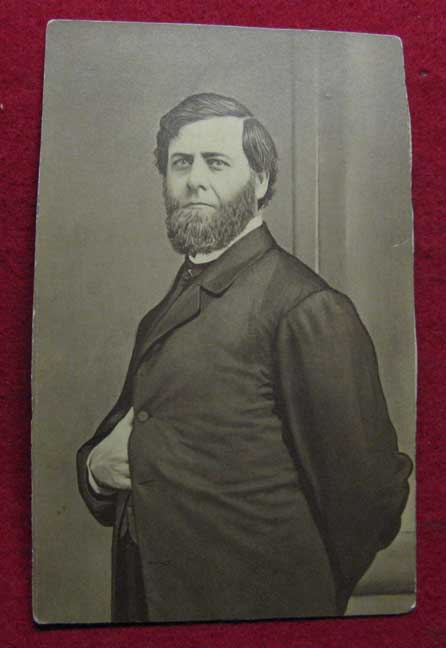Lafayette Avenue Presbyterian Church - Table of Contents
History of Lafayette
Avenue Presbyterian
Church
875 Elmwood Avenue, Buffalo, NY
1832 Members of the First Presbyterian Church, then on Main at Court Streets, leave the congregation 1833 Church building #1 - north side of Court House Square 1839 Reorganize as the Park Church Society 1845 Church closes 1845 Under Rev. Grosvenor W. Heacock, congregation reorganized once again as the Park Church Society 1850 Fire from the American Hotel destroys church building 1851 Rebuilt church (Church building #2) on same site at a cost of $9,000 1863 Church building #3 1877 Heacock dies 1878 Court House Square renamed Lafayette Square
1896 Bouck Street renamed Lafayette in honor of the church 1896 Church building #4 - Lafayette and Elmwood (land around church still used for cattle grazing)
  Rev. Grosvenor W. Heacock served as pastor 1845-1877 Photo courtesy of Stephen Osman, Minneapolis, MN  Rev. Grosvenor W. Heacock Painting by Elvi Jo Dougherty iin the Church Wall of History 
Lafayette Presbyterian Church on Lafayette Square Source: The Picture Book of Earlier Buffalo, Frank H. Severance, ed. Buffalo Historical Society Publications, Vol. 16, 1912 Left:
Buffalo
German Insurance Co. Building on Lafayette Square
Center: Lafayette Presbyterian Church Right: Rooming house on Lafayette Square

(1887) Lafayette Presbyterian Church on Lafayette Square  Lafayette Presbyterian Church on Lafayette and Elmwood Painting by Elvi Jo Dougherty in the Church Wall of History  Lafayette Presbyterian Church on Lafayette and Elmwood West elevation (on Elmwood Avenue) of Lafayette Presbyterian Church on Lafayette and Elmwood (land around church still used for cattle grazing) Photo source: Archives of Lafayette Presbyterian Church
|
|
Reprint Lafayette Avenue Presbyterian Church - 1894 Founded
14 March, 1832
The
Lafayette Presbyterian Church,
as it is known today, originated as the First Free Congregational
Church.
On 14 March 1832 twenty-one members of the First Presbyterian Church, then on Main at Court Streets, left the congregation. They desired to establish a church with a free seat plan, where members were not obligated to pay pew rents. They began holding services in a rented second floor room on Pearl Street without the benefit of a preacher. In October, 1832 with thirty-five members, they began meeting in the court house. Court House Square (later named Lafayette Square) In June of 1833, the congregation acquired a lot on the north side of Court House Square (Lafayette Square) on the site currently occupied by the Rand Building. After breaking ground on 4 July, they conducted their first service in the building in December [church building #1, 1833-1845]. In 1839, they reorganized as the Park Church Society, worshipping under that name until the early part of 1845 when the church closed. Grosvenor W. Heacock Era On 8 June, 1845 Rev. Grosvenor W. Heacock held a service in the Park Church, and with 150 people attending, saw hope in reestablishing the congregation. At this time he began a pastorship which would last for more than thirty years, until his death on 6 May, 1877. On 13 July, 1845 he reorganized the congregation once again as the Park Church Society. They carried this name until the city renamed the square on 1 December, 1879. In August, 1878 it was suggested to rename the square Heacock Park in honor of Grosvenor Heacock. After the council rejected that and the subsequent proposal to call it Washington Park, they elected to call it Lafayette Square in honor of the 1825 visit to the city by the Marquis de Lafayette. During his visit here, he spoke form a platform in front of the Eagle Tavern across the square on Main Street between Court and Eagle. The congregation prospered for the following five years. On 11 March, 1850 a fire in the American Hotel spread to their building and destroyed it. With the walls still standing, they were determined to rebuild. On 5 January, 1851 they conducted their first service in the rebuilt church. By the early 1860s the congregation had outgrown their church and began planning for a more spacious house of worship. On 13 April, 1861 they purchased the adjoining lot fronting Washington Street from Mrs. Phoebe Smith and began an ambitious building campaign. In 1863, they began worshipping in the new $25,000 building. Their stay there was short lived as by 1894, their number could no longer be comfortably accommodated. At this time, they began planning for the construction of the current building, deciding to relocate in the northern part of the city to keep pace with the residential development there. Elmwood and Lafayette On 8 November, 1894, amid the pastures and farm lands of the northern section of the city, the congregation broke ground for their new house of worship. With the completion of the new building, they moved from Lafayette Square. At that time, the street in front of their new church was known as Bouck Street. The church requested that the city rename the street Lafayette in honor of the congregation. In doing so, it became one of the few churches in the world to have a street named after it. Lafayette Theater At the time of their move, the congregation arranged to have their former building sold for conversion to a theater. As they felt it would be improper to sell church property for theatrical purposes, an arrangement was made with Nathaniel W. Norton, President of the Board of Trustees, and his brother Herbert, whereby title to the property would be passed on to them. They would in turn sell the property, remitting the proceeds back to the church. In doing so, the Nortons, without the knowledge of the congregation, added $52,000 onto the asking price for the property. When the sale passed, the price became a matter of public record and the congregation learned of the discrepancy. The church proceeded to sue the Nortons to recover the difference, winning the case in November, 1908. |
